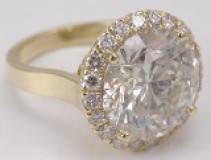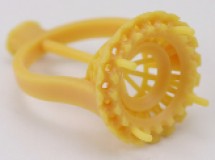Carter Lee is a 2nd generation Chicago based jeweler and years of working in a hyper-concentrated venue like Jewelr’s Row only served to show him how little has changed compared with the compelling advancements in personal manufacturing. It was this realization that served as the impetus to combine the entrepreneurial and creative sides of his personality to found the Chicago Charm Company. Starting a jewellery business has never been an easy undertaking — the industry is established, customers tend to be loyal in their patronage and that makes it difficult to grow a customer base if nothing new is brought to the table.


Enter the Digital Workflow
The earliest 3D design software packages were limited and mostly derivatives of tools used by industrial and mechanical designers. Jewellery designed using this early software looked as if it belonged more inside a transmission case than on a finger. “Thankfully, the tools have evolved and new ones introduced to let jewellers be as expressive as their abilities can carry them.” With that, Carter began the journey of using the new workflow. Designing in 3D permits countless opportunities to non-destructively explore variations or make changes according to each client’s individual needs.
It’s one thing to design jewelry in the virtual world of the computer but to transition it into the real-world requires another crucial component, the machine. Machines that exhibited the level of detail needed by jewellers had mostly been within the exclusive reach of well-funded service bureaux. “All my early 3D printing projects were sent to various service bureaux, but it quickly became apparent that this workflow wasn’t sustainable,” Carter explained. “It’s like deciding the copy-shop is still the proper venue for laser printing in today’s environment. It wasn’t just about the service bureaux’ soaring print fees,” explained Carter, “that disconnect introduced all sorts of back-and-forth.” He concluded that securing his own 3D printer was imperative.
The Move to In-house 3D Printing
At the time when his 3D design, modelling and sculpting abilities coalesced, personal 3D printers began emerging and became considerably more attainable. Which one was right though? Carter and many of the bench jewellers he knew took pride in curating their workbench tools to perfectly match their needs — “Focus on choosing the best and you’ll only have to buy it once. Buy cheaply and you’ll often end up buying a 2nd time.” 3D printers are no different in this regard.

With the printer decision confidently locked, Carter now spends his time focused on design rather than mired in continuous tweaking and fixing. As an example of how 3D printing shines over previous subtractive manufacturing methods, an associate jeweller asked Carter to design a fortune cookie charm. The folded geometry introduces hollow regions that would otherwise be impossible to cleanly access with a CNC mill. Not only can a 3D printer make a single, unbroken object in one pass, the object was successfully direct-cast with ease. That’s labour, time and material saved in one fell swoop. “When I show this process to fellow jewellers, you can see their eyes widen and their minds blown,” says Carter. “I’ve demonstrated the cookie charm was a cast-ready model within a day of inception. When that light-bulb moment hits they start thinking about all those countless projects they previously couldn’t do. With this advantage, I plan on bringing charms and all manner of jewellery that standout from the crowd.”
Ongoing Support
“Approximately a month into owning my printer, envisionTEC developed some improvements to the Perfactory Micro. In an unexpected move, they offered to ship out a replacement to existing users and picked up the tab for return shipping on the old machine. I’m not sure that those other candidates would have been as dedicated to refining their product. Looking back at this journey, it’s gratifying how the printer fit so well into my workflow. This is especially emphasized when observing the issues other 3D printers are still trying to work out. Like many of the other tools at my workbench, the Perfactory Micro has proven to work astonishingly well and reliably whether printing models for my own clients or associates. It’ll be the most important part of my business’ equation through the foreseeable years to come.”
Although an increasing stream of fellow jewellers and new clients continue to seek Carter to help bring their projects to fruition, he’ll try his best to carve out moments to post his progress and experiences on his website, which is not yet live but should be coming on line soon. Keep an eye out for it: www.chicagocharmcompany.com


